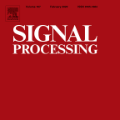Multivariate time series are ubiquitous objects in signal processing. Measuring a distance or similarity between two such objects is of prime interest in a variety of applications, including machine learning, but can be very difficult as soon as the temporal dynamics and the representation of the time series, {\em i.e.} the nature of the observed quantities, differ from one another. In this work, we propose a novel distance accounting both feature space and temporal variabilities by learning a latent global transformation of the feature space together with a temporal alignment, cast as a joint optimization problem. The versatility of our framework allows for several variants depending on the invariance class at stake. Among other contributions, we define a differentiable loss for time series and present two algorithms for the computation of time series barycenters under this new geometry. We illustrate the interest of our approach on both simulated and real world data and show the robustness of our approach compared to state-of-the-art methods.
翻译:多变时间序列是信号处理过程中无处不在的物体。 测量两个对象之间的距离或相似性对于包括机器学习在内的各种应用最为重要, 但一旦时间序列的时间动态和表达方式不同, 即观测到的数量的性质不同, 就会非常困难。 在这项工作中, 我们提出一种新的远程核算, 既包括地物空间和时间变异性, 也包括时间对齐, 并将其作为一个联合优化问题。 我们的框架的多功能允许根据所涉的易变类别进行几种变异。 除其他贡献外, 我们定义了时间序列的不同损失, 并在新的几何形状下提出计算时间序列中标的两种算法。 我们展示了我们对模拟数据和真实世界数据的兴趣, 并展示了我们方法相对于最新方法的稳健性。


